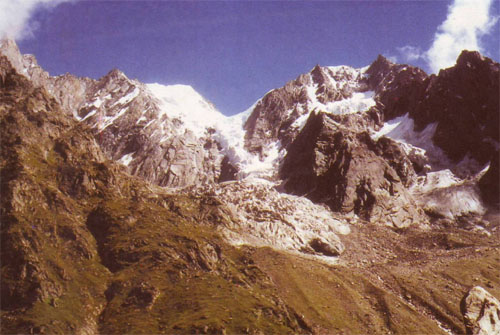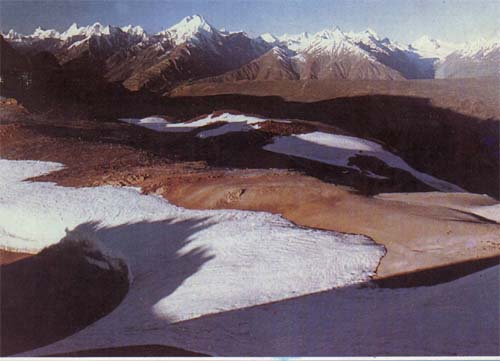Jan 05, 2026
Jan 05, 2026
'Global temperatures are rising', 'glaciers are melting' such news captions catch our attention faster. Like crime news they make great reading, yet we cannot do anything about the phenomenon. We are helpless readers. Some vociferous ones make a hue and cry and end up blaming the governments or the society. Well the glaciers are retreating, but are we competent to stop their retreat? We can not stop them either from retreating or advancing. But yes we must know how much is the precise change in the glacial mass since past. Advancements in technology have made it possible to determine the retreat, using the Total Station Survey and measure the area vacated by the glaciers since geological past. That is what H.C. Nainwal, B. D. S. Negi, M. Chaudhary, K. S. Sajwan and Amit Gaurav of Department of Geology, HNB Garhwal University, Srinagar (Garhwal), Uttarakhand attempted for Satopanth and Bhagirath Kharak glaciers at the head of the Alaknanda valley in Chamoli district, Uttarakhand. A retreating glacier leaves plenty of foot prints in the form of moraines and geomorphology. But in order to study the changes on the glacier body within past few hundred years the study of the glacier's snout position is considered one of the reliable methods. It is an irony that most of the good and bad things in human lives started since 1850. This year is considered to herald the industrial revolution. Therefore on one hand it gave us all the comforts of life and on the other it acted as a hearth for the nature. For the contemporary society now it is most convenient to blame the revolution. The blame game and nature's actions both will continue. It is also an irony that the glacier snouts have suggested general retreat since 1850. We know that glaciers are made of ice. And we also know that ice melts with heat. Imagine if the glaciers stop melting! There would be a total chaos. The rivers will go dry, sea levels will fall, and dusty winds will sweep the plains. The clouds of dust may be so thick that we may pray for Sunlight. On the other hand excess melting of glaciers can lead to submergence of vast areas. The Alaknanda and Bhagirathi Rivers are two major tributaries of the Ganga River. Satopanth and Bhagirath Kharak glaciers are the sources of the Alaknanda River. Both glaciers are revered by the Hindus in India. As per the mythology Yudhishtir trekked to heavens through Satopanth followed by his faithful dog. The Satopanth and Bhagirath Kharak glaciers are approximately 13 and 18.5 km long with an average width of 750'850 m, covering an area of 21.17 and 31.17 sq. km respectively say Nainwal et al in their publication. The Satopanth glacier has a higher gradient than that of Bhagirath Kharak. A glacier, as I have said in earlier articles too, is not a lump of ice. It is something alive without life. These glaciers are full of gaping crevasses and. Satopanth glacier showed more retreat on the left lateral margin. It had retreated by 1175.15 m between 1962 and 2005 with an annual average retreat of 26.90m/yr. Whereas the right lateral margin showed a retreat of 830.36 m during the above period with an annual average retreat of 18.87 m/yr. Between 1962 and 2005 the mean annual retreat of Satopanth glacier was 22.88 m/yr record Nainwal et al, whereas for the year 2005-2006 it was only 6.5 m/yr only. Bhagirath Kharak glacier on the other hand displayed a different pattern of retreat. Nainwal and his colleagues observed that in September 2005 the snout was at 3785 m on the left lateral extension of the glacier. After a year by September 2006 it had shifted to 3768 m on the right lateral margin of the glacier. Thus the snout had just changed sides with a retreat of only 1.5 m in one year. However, like its counterpart Satopanth, the average rate of retreat of Bhagirath Kharak during the period 1962-2005 was 7.42 m/yr. with a total retreat of 319.74 m in 39 years.
A typical hanging glacier in Central Himalayas
The eastern slopes of Chaukhamba group of peaks feed the ice to these glaciers. Ranging from 5288 to 7068m these peaks get plenty of snowfall during the winters. These two glaciers are separated by a linear ridge. Both the glaciers have a sinuous course as their paths are obstructed by a number of spurs. These glaciers are a part of the upper Alaknanda basin through which the Trans Himadri Fault passes. Because of this fault the glacio-fluvial (glacier and river borne) deposits on the periphery of these glaciers have deep cuts claim Nainwal et al.
It will be interesting for the readers to know that the Survey Of India Maps very precisely show the positions of snouts of the glaciers. The survey maps are continuously revised and all features like glacier snouts, springs etc are appropriately depicted. As per the survey map of 1962 the positions of the snouts of Satopanth and Bhagirath Kharak glaciers were at 3745 m and 3750 m respectively say Nainwal and his co-workers. While during actual measurements with Total Station Survey in September 2005 and 2006 they found the snout of Satopanth glacier at 3866.34 m and 3868.23 m respectively. The snouts were found situated on the southwestern margin of the glacier. They observed that between 2005 and 2006 the glacier showed a total retreat of 6.5 m with no obvious change in shape and size.
The data of retreat of Satopanth and Bhagirath Kharak glaciers for the period 1962-2005 revealed that they vacated an area five to ten times more between this period than during the period 2005-2006 when the rate of retreat had slowed down by 82% and 90% respectively.
The observation of Nainwal and his colleagues supports the observations of the glaciologists from GSI, when Sidhhartha Swaroop and his colleagues recorded a decline of annual recession by 63% and 54% for Dunagiri and Chaurabari glaciers respectively. Similarly Gangotri Glacier has also shown a significant decline in its recession (Read: Is Gangotri Glacier in Real Peril) in the recent years.
We know that glaciers are made of ice. And we also know that ice melts with heat. Imagine if the glaciers stop melting! There would be a total chaos. The rivers will go dry, sea levels will fall, and dusty winds will sweep the plains. The clouds of dust may be so thick that we may pray for Sunlight. On the other hand excess melting of glaciers can lead to submergence of vast areas; the hydroelectric projects in the Himalayas may face a shut down due to flooding! Thus excess melting of ice or zero melting both are bad for mankind. But it is beyond our means to control the melting of ice. Yes we can stop polluting the higher reaches of Himalayas, start planting trees in reality and not on paper alone, and reduce carbon emissions. All these measures would be for our benefit. Whether they will reduce the retreat of glaciers or not, only time would tell!
Glaciers have been spreading and shrinking since geological ages. That is why Francois Villon (1461-85) the French poet wrote in his Le Grand Testament (The Great Testament) (1461):
04-May-2008
More by : V. K. Joshi (Bijji)

|
Dear Ashok, I am not a glaciologist. But yes since I am an environment journalist I recommend that you get in touch with Dr Deepak Srivastava, Director (He is the Head) of the Centre on Himalayan Glaciers-presently operating from Wadia Institute. He will be able to suggest you the desired topic for research. Whatever research you undertake please always try to evaluate how much your research will be affected the common man in Uttarakhad. Best wishes. |

|
dear sir, my self ashok aswal presently serving as a JRF in uttarakhand space application center dehradun in on going project "Monitoring of Snow And Glacier". I am PG in Remote Sensing & GIS Application from HNBGU Srinagar. I am interested in PhD in this field. Sir Please Suggest me some specific topics in this context Specially on uttarakhand himalaya. with this hope thanking you. Ashok Aswal mob. 8126071844 |